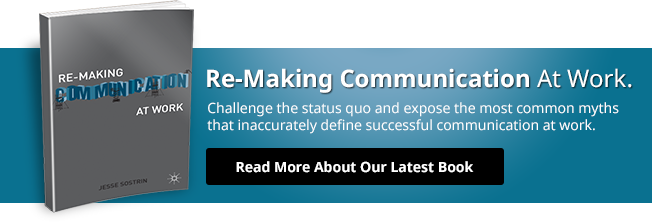No Shortcuts to Effective Communication
The thing about shortcuts is that there are no short cuts to effective communication. Despite the prevalence of three-step processes to get difficult conversations right, listen better, persuade others, etc. it takes a deeper level of focus and effort to shift unwanted patterns of communication. However, re-making communication at work can have dramatic effects on individuals, teams, and organizations, for example:
Two business partners are locked in a battle of wills, both feeling supremely confident that their strategy and approach to leading the business is sound. Believing that their partner’s ideas are flawed, their persistent disagreement reduces the trust between them and the partnership dissolves as the business erodes in a wash of unmade decisions and acrimonious discussions . . .
The Board of Directors in a once-inspiring nonprofit uses their quarterly meetings to play out a turf war with lines drawn around the founder and former executive director and the new executive director’s management team. With good intentions and right on every side, both camps fail to effectively lead the organization and, over time, they compromise the relevance of the mission and the organization’s financial stability . . .
A new manager responds to a surprise promotion with passion and motivation for making her mark. Several of her newly assigned direct reports had been friends as they all came up together in the organization. In the transition to “boss,” she is unable to adapt an equitable and consistent way of working across the team. With sagging credibility and frustration all around, her aspiring leadership fades as undermining activities reduce collaboration and morale . . .
Some people could read these three scenarios and cynically say, “That’s just how it goes in the real world of work.” While it may be true that these kinds of unwanted, destructive patterns of communication and interaction can be part of our everyday working lives, taking a communication perspective at work reminds us that nothing is fixed. Even the most challenging patterns can be re-made.
. . . After a seemingly intractable conflict, two business partners find common ground in the love for what they do. As they work through their differences, they deepen their respect for each other’s unique values and principled way of working. Over time, the business thrives as they balance their roles and let organizational decisions, not personalities, lead the way.
. . . After a fractious time made worse by difficult economic circumstances, a nonprofit Board of Directors suffers a series of community relations issues as their in-fighting spilled over into the community. Facing the possibility of closing the doors, they choose to put personal convictions aside and form a new vision that preserves the tradition of the past and captures the excitement of the future. With their full support behind the staff and a commitment to more constructive ways of discussing future concerns, the mission thrives once again.
. . . After a rough six months on the job, a new manager develops a versatile approach to leading her blended team. Working through challenging relationships and a few skeptical personalities, she learns to make hard decisions by establishing consistent accountabilities and shared responsibilities. As her confidence grows, so does the respect and commitment she maintains from her team.”
In hallways, boardrooms, around cubicles, and in corner offices people are living with what they have made with their communication at work. The very fabric of organizational culture is a reflection of these deep and enduring patterns of communication and interaction. And, although there are no shortcuts to changing unwanted patterns, there are a few plain-language reminders that simplify the opening moves to start:
- Those headaches at work that we experience working with others . . . we can get rid of them.
- One of the reasons they stick around is because they’re connected to deeper issues that have grown roots.
- Behind every communication breakdown, each difficult experience with a colleague, all of the wasted meetings, and the past efforts to change there are “patterns of communication and interaction” that actually make that stuff.
- Our experiences and the outcomes we get are actually made by the habitual ways we interact with other people.
- If we change the way we communicate and interact, then we can remake those headache-causing experiences into something better.
Dr. Jesse Sostrin can help your team identify and re-make the critical patterns of communication that sustain unwanted outcomes in your organization. If you’re tired of dealing with the burden of unresolved conflict, eroded trust, collaboration failure, and declining performance, then start your Discovery Session now to create the conditions for the changes you seek.

